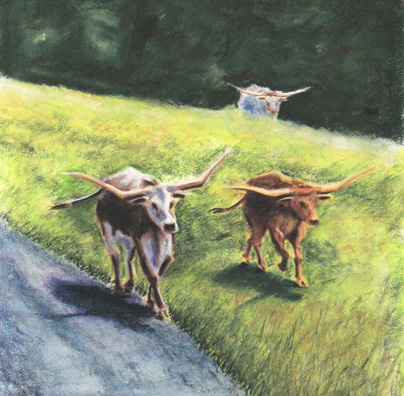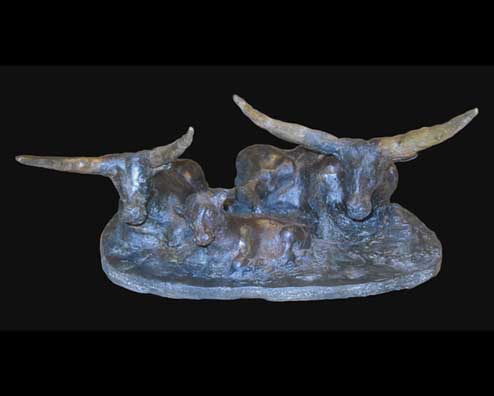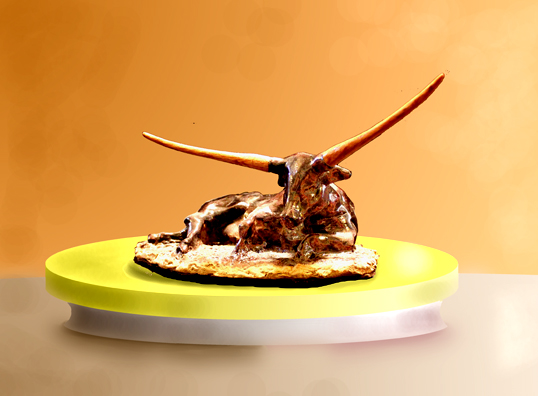Longhorn Cattle

Longhorn Cattle
It's a bit strange that we think longhorn cattle with their long horns are strange. Actually cows had long horns throughout most of their history and even back into prehistoric times. There are rock paintings on the Tassili n'Ajjer Plateau in Algiers from over 8,000 years ago that show herdsmen watering their cattle which definitely have long horns. Cattle raised in Ancient Egypt also had lengthy and curving cornua and today the somewhat misnamed Watusi cows have horns that are even larger than those of their American cousins. The horns of Watusi cattle, properly called Ankole, are surprisingly light because like all cow horns, they are not solid.
In any case, a congealing opinion of the experts is that today's cattle breeds arise from an extinct variety called the aurochs. Their horns were not as long as the Texas or Ankole breeds, and the aurochs looked a lot like Spanish fighting bulls. They were, though, larger, and some probably hit ¾ of a ton. At one point they ranged throughout Africa, Asia, and Europe, and their earliest clear-cut depiction is from a cave painting going back at least to 17,000 BCE in France. Actually the aurochs - the plural is the same as the singular - lasted a long time and only went extinct in modern times, the mid-17th century as a matter of fact.

Ankole (Watusi) Cattle
By the mid-sixteenth century, though, the precursors of the Texas longhorn were well established in the American southwest, as the Spanish corriente cattle. Eventually, some of the Spanish cows got loose - as did the horses - and they took to the wild. As a result, the longhorn was not bred deliberately like other cattle but was a result of natural selection. Of course, the 300 year span to the 19th century wasn't enough time to produce a new species, but at least it was sufficient to produce the long thin horns of considerably varying curvature which is characteristic of the breed.

The Longhorn
(Ceramic and Oak)
The Texas longhorn formed the basis of the famous Old West cattle industry that arose after the Civil War. Everyone knows the story of how Charles Goodnight and Oliver Loving drove a herd of longhorns from West Texas to Colorado along what became the Goodnight-Loving Trail. But that was not the first cattle drive. Cattle had been driven to market as long as there had been markets and there are writings from Rome about herders driving cattle. But in the United States, the first long range cattle drive was from Texas to New Jersey just across from New York City. This drive was organized by the Illinois rancher Tom Candy Ponting in 1853. After resting for the winter on his Illinois ranch, he drove 150 of the cows on to New Jersey.
A "classic" cattle drive began in Texas and the drovers (the word - ptui - "cowboy" was not favored by the men themselves) were paid about $100 for three months of work. The jobs included rounding up and branding the cattle. They rode horses owned by the rancher but had to provide their own saddles. They were provided food ("and found") but extraneous expenses were deducted from their pay. As one famous song put it:
I went to the boss for to draw my roll.
He had it figgered nine dollars in the hole.
Once the cattle were delivered to the railyards, the men were paid off. Before returning home, they could spend a few days in the cowtowns. What they did depended on the individual inclinations. Of course, you read about them riding through the towns shooting their guns and terrorizing the citizens. And there were - ah - "attractions" in establishments that were "on the other side of the tracks". But one cowboy was walking by a church, and upon being invited in, spent the next hour in a Sunday school class. He said it was the most peaceful and pleasant time he had since leaving Texas.
For most of the men (their average age was twenty-three) one cattle drive was enough. They took a train back home and found some other line of work. The ranchers eventually replaced the longhorn with the now ubiquitous Hereford, and by the mid-1880's the railroads had extended into the cattle raising country. It was possible to ship cattle directly from Texas to Chicago and New York, and the long range cattle drives were over.
Today longhorn cattle are mostly kept as pets. Of course, we don't mean house pets, but they are raised on farms and ranches mostly because it's neat to have longhorn cattle.
References
The Life of Tom Candy Ponting, Tom Candy Ponting, Branding Iron Press, 1952.
The Cowboys, William Forbis, The Old West, Time-Life Books, 1973. A nice introduction although you have to be careful as some facts are not double-checked. The introductory chapter talks about the Old West cowboys singing "There's an Empty Cot in the Bunkhouse Tonight". Alas, this song was written in 1944 by Gene Autry, who as we all know was the long time owner of the Los Angeles Angels baseball team. A personal CooperToons opinion is the best rendering of this iconic song is that by Rosalee Sorrells.
We Pointed Them North, Edward "Teddy Blue" Abbott and Helena Huntington Smith, Farrar and Rinehart 1931. It's a bit difficult to determine if the tales of the cowboys were stretched a bit. But most people take what Teddy Blue said as face value. His claim to have met Calamity Jane was verified as there is a photograph of both of them together - or at least Teddy Blue said that was him wearing the flowered hat.
Up the Trail in '79, Baylis John Fletcher, University of Oklahoma Press, 1966. Another first hand account of a trail drive whose accuracy is pretty much accepted - although Baylis did spend some time in later life as a politician.
"No More Mystery Meat", http://evolution.berkeley.edu/evolibrary/news/130401_beef.
"Texas Longhorns: A Short History", International Texas Longhorn Association, http://www.itla.net/longhorn_information/index.cfm?con=history.
"Breeds of Livestock - Corriente Cattle", Breeds of Livestock, Department of Animal Science, http://www.ansi.okstate.edu/breeds/cattle/corriente.